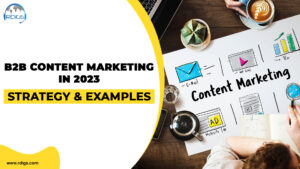Updated May 2023: The results of your content mostly depend on the quality of your B2B content marketing strategy. Recent artificial intelligence (AI) developments have flooded the internet with a tsunami of new content — its calibre is questionable. B2B marketers and entrepreneurs need to be more strategic than ever with content marketing to build credibility and rise above the mediocre.
Today content marketing has become an essential instrument for b2b companies to communicate with their audience and gain exposure in this extra-competitive environment.
Executing B2B content marketing strategies involves creating and distributing valuable online content to a targeted business audience; this process aims to drive brand awareness progressively, website traffic, lead generation, and sales.
A B2B content marketing plan aims to get you in front of your ideal customers and help you solve their problems. Your content should make people feel like they owe you something so they want to do business with you instead of your competitors.
It’s more complex than slapping together a spreadsheet of target keyphrases or tweeting 10 times a week. Your content marketing strategy must start with a deep knowledge of your target customers.
In this blog, we’ll teach you everything you need to know about driving growth for your business with content marketing.


What is Content Marketing?
According to the Content Marketing Institute:
“Content marketing is a strategic marketing approach focused on creating and distributing valuable, relevant, and consistent content to attract and retain a clearly-defined audience — and, ultimately, to drive profitable customer action.”
Did you know that 90% of B2B buyers think it’s important for companies to provide useful content at all stages of the buying process, not just at the acquisition and purchase stage?
A B2B content marketing strategy is a plan for how your company will reach certain business goals using content marketing (a form of inbound marketing rooted in relationship building, as opposed to outbound marketing like advertising).
The B2B aspect means the marketing strategy targets other businesses rather than individual consumers.
B2B Content Marketing vs. B2C Content Marketing
The biggest difference between these two strategies is that the former targets individual consumers while the latter targets companies.
However, even in the B2B world, you’re still marketing to human beings within your target companies. So, while your marketing tactics and channels might differ (think LinkedIn vs. Pinterest), you still need to cover the basics, like creating an emotional connection with your audience.
One of B2B marketers’ and entrepreneurs’ biggest mistakes is creating soulless content. B2B audiences like to be entertained, too!
In B2B marketing, more decision makers tend to be involved in purchasing decisions and are often highly focused on return on investment. B2B products and services are generally more complex than consumer goods and services and require content marketing that educates potential buyers and helps them solve problems.
While some of the content types overlap within B2B and B2C content marketing, the primary difference between the two content marketing types is the target audience.
B2B companies sell their products or services to companies or organizations, while B2C companies sell their products or services directly to consumers.
B2B marketing strategies for 2023
Here are some effective B2B content marketing strategies that you can implement in 2023:
1.Buyer Persona Research: Understand your target audience’s pain points, challenges, and goals. Create detailed buyer personas to tailor your content specifically to their needs. This will help you create personalized,
targeted content that resonates with your audience.
2.Video Content: Invest in video content as it continues to be a powerful tool for B2B marketing. Create engaging and informative videos highlighting your products or services, demonstrating use cases, or providing valuable insights. Consider incorporating live videos, webinars, and interviews with industry experts to drive engagement and establish thought leadership.
3.Influencer Partnerships: Collaborate with industry influencers and thought leaders to expand your reach and build credibility. Identify influencers relevant to your industry and target audience and engage them in content creation, such as guest blogging, social media takeovers, or co-hosted webinars. Their endorsement can help you gain visibility and trust within your target market.
4. Account-Based Marketing (ABM) Content: Tailor your content strategy to align with your account-based marketing efforts. Create personalized content for specific target accounts to address their unique challenges and showcase how your products or services can provide solutions. This could include customized case studies, industry reports, or personalized email campaigns.
5. SEO Optimization: Optimize your content for search engines to improve organic visibility. Conduct keyword research to identify relevant keywords and incorporate them strategically into your content. Focus on creating high-quality, informative content that aligns with search intent and earns backlinks from authoritative websites.
6. Email Marketing : We’ve already discussed newsletters as a solid B2B content marketing format, but when it comes to using email as a promotion tactic, you need to build up your email list to have a database of people to send to.
To do this, you can consider things like:
- Including a newsletter sign-up box in your content to capture readers while they’re enjoying other pieces
- Displaying a sign-up box on all pages of your site
- Capture email addresses via content assets such as tools and checklists. This guide on 29 Simple Ways to Grow Your Email List is a great starting point for more ideas.
Discover the Latest Insights and Clear Your Doubts with Our Recent Blog B2B Email Marketing Tips
7. Content goals and tactics: Now it’s time to think about what you want to accomplish with your content and how it will support your company’s overall business objectives. Do you want your audience to sign up to your email list? Register for a webinar. Book a product demo? Determine your content goals with a few examples to get you warmed up.
Your next step is to determine the content marketing tactics you’ll use. Here are a few ideas:
- Drive organic traffic to your website through blogging
- Start a podcast to create deep connections with your audience
- Publish customer stories to showcase your products and services in action
- Humanize your brand by sharing short-form video content on your social media channels
- Establish partnerships with like-minded organizations and “borrow” one another’s audiences to increase your brand’s exposure
- Tempt potential buyers to join your email list with gated content (or, if you prefer to offer value with no strings attached, create an ungated resource)
How to create content marketing strategy
Knowing what goes into a business-to-business content marketing strategy is the first step. To get it built, you’ll need to collaborate with your team. Take advantage of these steps.
1. Gather key stakeholders
To create a winning strategy, you need input from subject matter experts (SMEs) in product marketing, social media marketing, sales, customer success and more. Your team may be small, but the key is seeking other perspectives early in the planning process to get their buy-in and uncover any pressing concerns.
You could start by talking to your sales team to find out what case studies they need to help them close deals. They may be looking for customer stories from specific industries or showcasing results from a particular product in your offerings.
2. Determine your goals
With your SMEs’ guidance, you can now set goals that fit the timeline and budget you have to work with. We’ll skip over the SMART goal framework, but it’s worth a read if you’re new to the concept. The bottom line is to ensure you have carefully crafted goals and team consensus on these strategic objectives before you draft the rest of your plan. See the goal examples in the previous section for inspiration.
3. Assign roles and responsibilities
Every successful plan includes information on who will do what and when. So, develop a content workflow outlining how your team will collaborate to finalize your strategy and start implementing it. Who will oversee the competitive analysis, tactic and topic ideation, keyword research and content calendar? Who will communicate with your external vendors (if applicable)? Get everything in writing with a deadline.
4. Set project milestones
Arrange check-ins with your team members to monitor the results of your B2B digital marketing strategies. Build time into your schedule to adjust your content formats or specific keywords.
Tracking content performance over a specific period will tell you how successful your efforts have been. Depending on your KPIs, you may look at social media shares or the number of new email subscribers gained from the content.
5. Optimize and repurpose your content
Optimizing old content should be part of your business-to-business content marketing strategy. Repurposing content into different formats should also be part of your plan. These activities can help you reach more people and solidify your credibility on specific subjects without always having to pump out something new.
Conclusion:
B2B content marketing in 2023 offers opportunities to connect, engage, and build relationships. Personalization, video, interactivity, influencers, and thought leadership are key. SEO optimization, data-driven insights, and content repurposing drive visibility and conversions. Stay adaptable to succeed in the evolving landscape.

